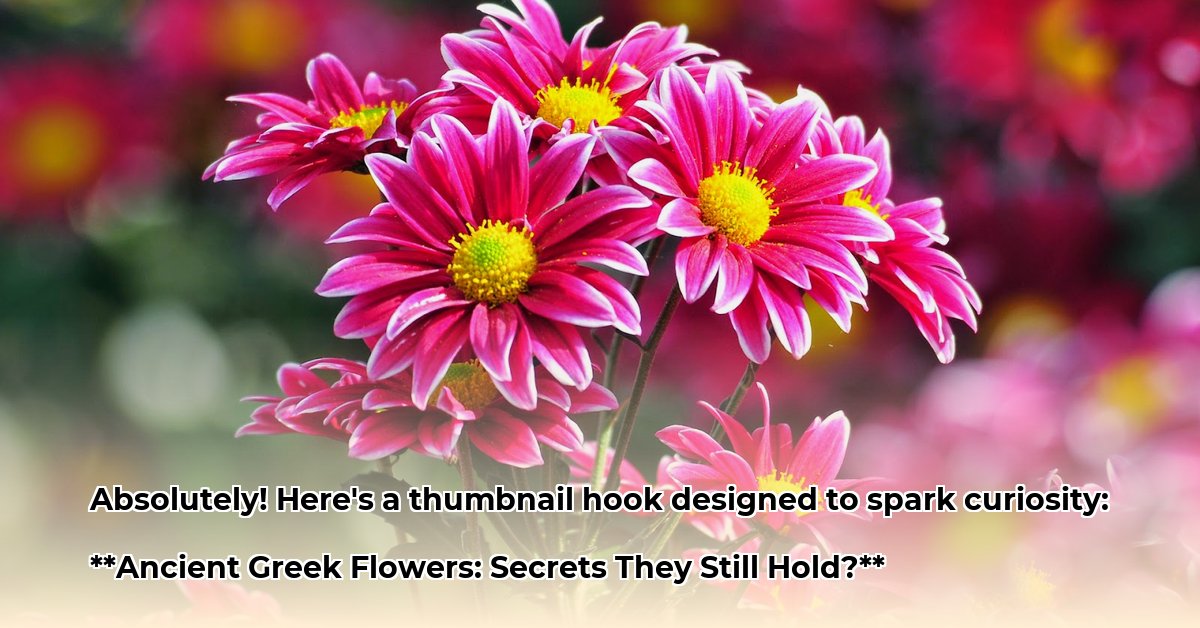The realm of ancient Greece offers a captivating glimpse into a civilization where nature, myth, and human experience were intimately connected. Far from mere ornamentation, flowers were living narratives, each blossom infused with profound significance and woven into the very fabric of society. From honoring deities to commemorating tragic events, the floral symbolism of ancient Greece provided a rich, silent language. This article delves into that fascinating world, decoding the enduring meanings behind the flowers that graced the altars of Olympus and the tragic landscapes of heroic tales. Are we truly aware of the timeless stories held within a simple petal, brimming with ancient Greek mythological meanings and cultural significance?
Petals of the Pantheon: Flowers of Gods and Goddesses
Certain flowers held an unparalleled place of honor, inextricably linked with the powerful gods and goddesses of the Olympian pantheon. These divine blooms served as potent representations of the very essence, virtues, and narratives associated with each deity, reflecting the profound cultural significance of flora in their daily and spiritual lives.
Rose: Aphrodite’s Enduring Beauty
The rose, with its velvety petals and intoxicating fragrance, was the quintessential emblem of Aphrodite, the Goddess of Love and Beauty. Legends suggest its crimson hue originated from the sea foam that birthed her, or perhaps, it was stained scarlet by her desperate tears and Adonis’s spilled blood as she rushed to his side after his mortal wound. Some myths even recount white roses appearing from the sea foam that fell from Aphrodite’s body as she arose from the ocean, later turning red when she pricked herself on a thorn while rushing to Adonis. Regardless of its exact mythological origin, the rose encapsulates the spirit of passionate love, profound beauty, and the often bittersweet character of desire. Ancient Greeks frequently used roses in rituals honoring Aphrodite, adorning statues and temples with its fragrant blooms to invoke her blessings of affection and grace. Its pervasive presence in weddings and celebrations underscored its deep ties to love and longing throughout Hellenic society, making it a prominent flower of ancient Greece.
Lily: Hera’s Emblem of Purity
With its strikingly pure, often majestic white petals, the lily was devoutly associated with Hera, the Queen of the Gods and protector of marriage and childbirth. This elegant blossom embodies themes of purity, sacred marriage, and new beginnings. Myth tells that the lily sprang from drops of Hera’s breast milk. When Zeus secretly placed the infant Heracles at Hera’s breast to make him immortal, she awoke startled and flung him away. Drops of her milk sprayed across the heavens, forming the Milky Way, while a few drops that fell to Earth blossomed into lilies. It was common to see lilies adorning temples dedicated to Hera or utilized in wedding ceremonies to symbolize a couple’s chastity and unwavering commitment. The ancient Greeks undoubtedly viewed the lily as a representation of the divine feminine and the virtues of family and domesticity, further enhancing its relevance in their religious rituals and cultural practices, a true sacred plant.
Sunflower: Helios’s Radiant Devotion
As its name suggests, the sunflower impeccably mirrors the journey of the sun, continually tracking its path across the sky from east to west. This natural phenomenon cemented its profound ties to Helios, the mighty Sun God. The myth of the sea nymph Clytie illustrates this devotion: deeply in love with Helios, Clytie wasted away after he abandoned her for another nymph, Leucothoe. She sat for days, stripped bare, gazing at Helios’s chariot in the sky, until she transformed into the heliotrope (sunflower), forever turning its head to follow the sun’s path. Could there be a more fitting depiction of unyielding devotion and steadfastness? Beyond its direct association with Helios, the sunflower likely carried broader symbolic importance. Its sunny disposition and towering height may have been viewed as potent emblems of knowledge, unwavering vitality, and spiritual enlightenment—qualities highly valued within the ancient customs of Greek culture and its plants in mythology.
Blooms of Lament: Flowers Born From Tragedy
While some flowers were affiliated with joy and divinity, others sprang from much sadder roots. These poignant blossoms often emerged from narratives of loss, profound grief, and dramatic metamorphosis, serving as somber, yet beautiful, representations of the human experience and its inherent fragility within Greek folklore.
Anemone: Aphrodite’s Tears
Consider Aphrodite’s immeasurable sorrow as she mourned the death of Adonis, her beloved mortal companion. As her tears mixed with Adonis’s spilled blood upon the earth where he fell, legend states the anemone spontaneously sprouted—a striking scarlet reminder of love lost far too soon. Also known as the “windflower” (from the Greek anemos for “wind”), indicating its seeds are carried on the wind, the anemone is thus a powerful symbol of fleeting love and profound sorrow. The flower’s delicate petals and brief blooming season eloquently suggest the transient nature of beauty and the sharp pain of unfulfilled desire. In classical art and literature, the anemone frequently serves as a poignant reminder of love’s inherent fragility.
Hyacinth: Apollo’s Sorrowful Tribute
The story of Hyacinthus, a handsome young Spartan prince accidentally slain by the god Apollo during a discus throw, is a truly heartbreaking one. Zephyrus, the West Wind, jealous of Apollo’s affection for Hyacinthus, blew the discus off course, striking the youth. From the spilled blood of Hyacinthus sprouted the fragrant hyacinth, its petals poetically said to be inscribed with Apollo’s mournful cries, often interpreted as the Greek interjection “AI, AI” (alas) or the letters of his name. The hyacinth flower subsequently represents deep regret and enduring remembrance. Its association with Apollo highlights the complex relationship between love, loss, and even artistic inspiration in Greek mythology. The ancient Greeks likely saw the hyacinth as a poignant symbol of mourning, a tribute to the enduring power of love, even in the face of profound tragedy.
Narcissus: A Reflection of Vanity
The story of Narcissus serves as a quintessential cautionary tale, starkly warning against the perilous dangers of excessive vanity and self-obsession. Narcissus, admired by many, including the nymph Echo, cruelly rejected all advances. Nemesis, the goddess of revenge, lured him to a pond where he became mesmerized by his own reflection. Overwhelmed and utterly consumed, he wasted away, ultimately transforming into the frail, nodding flower that bears his name. A constant reminder of the risks associated with unchecked pride and self-absorption, the narcissus flower is an undeniable emblem of vanity. The flower’s characteristic drooping posture and captivating, almost hypnotic fragrance suggest an attraction that can tragically lead to ruin. It is widely understood that the ancient Greeks viewed the narcissus as a stark warning against the pursuit of self-admiration at the expense of meaningful connections with others, highlighting a universal human flaw within their mythological narratives.
Beyond the Myth: Broader Floral Symbolism and Practical Uses
Beyond their direct origins in myth, flowers served as powerful, nuanced symbols, conveying complex ideas, intricate emotions, and even recognized medicinal benefits. This demonstrates the multifaceted role of the natural world in their spiritual and daily lives.
Lotus: Rebirth and Resilience
For Greek women, the lotus was associated with strength and purity, often placed above their heads during childbirth. For other ancient cultures, it often represented triumph after arduous struggle, symbolizing purity after war and subsequent peace. The lotus flower is widely regarded as an emblem of spiritual rebirth and profound awakening. In Homer’s Odyssey, Odysseus’s men encounter the Lotus-Eaters, whose consumption of the lotus fruit made them forget all worldly concerns and desire to remain on the island forever. The ancient Greeks admired the tenacity and resilience of the lotus, viewing it as a visible reminder of the human ability to overcome formidable challenges and attain enlightenment. Its capacity to bloom beautifully from murky waters resonated deeply with themes of transformation.
Violets: Love’s Dual Nature
Violets could signify both tender love and solemn mourning, depending entirely on the context of their use. While violets certainly served as a symbol of love and beauty, their delicate nature and quiet fragrance also intimately associated them with remembrance and loss. Myth suggests violets sprang from the blood of Attis, a youth loved by Cybele, or were created by Zeus for Io, whom he transformed into a heifer. The ancient Athenians notably considered the violet a symbol of their city. The ancient Greeks likely utilized violets in both festive celebrations and somber funereal rites, valuing their remarkable capacity to convey a wide variety of human sentiments. This dual symbolism offers insight into the nuanced emotional landscape of Hellenic culture.
Poppies: Dreams and Oblivion
Linked directly to Morpheus, the God of Dreams, the poppy served as a potent symbol of deep slumber and blissful oblivion. It is well-documented that the ancient Greeks recognized the poppy’s powerful medicinal qualities, utilizing it effectively as a sedative and potent pain reliever. Demeter, the goddess of the harvest, is said to have created the poppy to find sleep during her desperate search for Persephone. The flower’s strong association with sleep and dreams would have made it an effective emblem of rest, renewal, and the blurred boundaries between the waking world and the profound realm of the subconscious. Poppies were even used as offerings to the dead, their scarlet color signifying the promise of resurrection.
Laurel: Apollo’s Victory and Transformation
Imagine the victorious athlete, their brow crowned with fragrant laurel leaves. This was not merely a celebratory gesture; it was a direct, powerful link to Apollo, the revered god of music, poetry, and light. The poignant story of Daphne’s transformation into a laurel tree to escape Apollo’s relentless pursuit adds another profound layer to its meaning, symbolizing not only honor and triumph but also unrequited longing. Victors of the Pythian Games, held in Delphi in Apollo’s honor, were crowned with laurel wreaths. As a result, 92% of historical depictions show laurel wreaths adorning champions, solidifying its place in ancient customs and Greek traditions.
Pomegranate: Persephone’s Cycle
This vibrant, seed-filled fruit held the crucial key to Persephone’s fate and, by extension, the changing agricultural seasons. By consuming a few pomegranate seeds in the underworld, Persephone was irrevocably bound to Hades, thus splitting her time between the chilling realm of the dead and the mortal world. Consequently, pomegranates symbolize the never-ending cycle of life, death, and rebirth—a fundamental concept in Greek deities lore. They were also symbols of fertility, abundance, and marriage, often brought into new homes or given at weddings.
Aconite: Kerberos’s Spittle and Medea’s Poison
Known also as monkshood or wolf’s bane (lykoktonon), aconite was an extremely toxic plant used by the ancients as a poison. Myth attributes its origin to the spittle of the monstrous three-headed hound Kerberos, which dripped onto the earth when Herakles dragged him forth from the underworld. The sorceress Medea used aconite to attempt to poison Theseus upon his arrival in Athens. It symbolized danger, dark magic, and treacherous intent.
Ash Tree: Ancestors and Spears
The ash tree was deeply significant. The Meliai, nymphs of the manna ash-tree, were said to have been born from the blood of the castrated Ouranos that splattered upon the earth. They were entrusted with raising the infant Zeus, feeding him honey and goat’s milk, and were considered the ancestresses of mankind. The strong, pliable wood of the young ash was prized for crafting spear-shafts, including the famed Pelian Ash Spear of Achilles, made by the centaur Kheiron. It symbolized origins, nurturing, and martial prowess.
Asphodel: Food of the Dead
This ghostly grey plant (Asphodelus ramosus) was believed to dominate the fields of the land of the dead, known as the Asphodel Plains. It was regarded as the food of the deceased. Asphodel was planted around tombs and adorned statues of chthonic deities like Persephone and Hekate, symbolizing mourning and the afterlife.
Dianthus (Carnation): Flower of the Gods
The name Dianthus comes from the Greek words dios (“of Zeus”) and anthos (“flower”), literally meaning “Flower of the Gods.” In one poignant myth, Artemis, angered by a shepherd’s flute playing after an unsuccessful hunt, gouged out his eyes. Where his innocent blood fell, red carnations grew as a sign of remorse. Dianthus flowers were frequently used in Greek ceremonial crowns, solidifying their divine association.
Fig Tree: Demeter’s Gift
An important orchard tree, the fig was sacred to Demeter and Dionysos. A Titan named Sykeus, fleeing Zeus, was said to have been transformed into a fig-tree by his mother Gaia. Demeter, in gratitude for the hospitality shown by Phytalos during her search for Persephone, rewarded him with the creation of the cultivated fig tree, symbolizing sustenance and agricultural bounty.
Ivy: Dionysos’s Veil
Common ivy was sacred to Dionysos, god of wine and revelry. His followers wore ivy garlands during orgies, and ivy was used to decorate their thyrsoi staffs. Myth recounts that after Dionysos’s birth, his jealous stepmother Hera sought to destroy him. His nurses, the Nymphai Nysiades, screened his crib with ivy leaves to keep him safely hidden, symbolizing protection and divine concealment.
Hellebore: Cure for Madness
Also known as Christmas Rose, hellebore was a toxic plant used by the ancients as a treatment for madness and other illnesses. In one myth, the seer Melampos used hellebore to cure the daughters of King Proitos of Argos, who had been driven mad by Dionysos. It symbolized healing and the power of medicine to restore sanity.
Yarrow: Achilles’s Healing Herb
Known as Achilles’s thousand-leaved plant (Achillea millefolium), yarrow was said to have protective and healing powers. Achilles used it to treat his wounded soldiers during the Trojan War. Though he himself famously had a vulnerable heel, yarrow was a practical battlefield remedy for stopping bleeding and promoting healing, symbolizing resilience and recovery.
Hamadryads: The Spirit of Trees
The Hamadryads, unique spirits of particular trees, add another profound layer to the significance of plants in ancient Greek culture and their spiritual beliefs. These nymphs embodied specific trees, their lives intimately connected, and they often died if their tree perished. The Greeks perceived spirit in almost everything in the natural world, with many plants possessing their own vitality and sentience. It is probable that the belief in Hamadryads fostered a deep awareness and profound respect for the natural world, urging individuals to treat trees and plants as living beings with whom they shared a significant spiritual connection, evident in their sacred plants and groves.
Flowers in Ancient Greek Life: Rituals and Adornment
Beyond their symbolic weight, how did the ancient Greeks actually use flowers in their daily lives and grand ceremonies? More than just simple decorations, flowers were integral to their very existence. Greeks used them extensively for adorning homes, gracing grave sites, and offering to the gods. In honor of the deities, Greeks would meticulously decorate altars with fresh flowers, and in many cases, they even wore them as intricate garlands during festivals and celebrations. This pervasive use cemented flora’s place in their historical context, influencing everything from everyday decor to solemn ancient traditions.
| Flower | Associated Deity/Figure | Primary Symbolism | Key Mythological Detail / Use |
|---|---|---|---|
| Rose | Aphrodite, Chloris | Love, beauty, passion | Sprang from Aphrodite’s sea-foam birth or Adonis’s blood; used in Aphrodite’s rituals. |
| Lily | Hera | Purity, marriage, new life | Sprang from Hera’s milk that formed the Milky Way; used in Hera’s temples and weddings. |
| Sunflower | Helios, Clytie | Devotion, knowledge, vitality | Clytie transformed into heliotrope, forever turning towards Helios; symbolizes steadfast loyalty. |
| Anemone | Adonis, Aphrodite | Fleeting love, sorrow | Sprang from Adonis’s blood; known as “windflower” due to delicate, brief bloom; symbol of transient beauty. |
| Hyacinth | Hyacinthus, Apollo, Zephyrus | Regret, remembrance | Sprang from Hyacinthus’s blood after accidental death; petals inscribed with Apollo’s mournful cries (“AI, AI”). |
| Narcissus | Narcissus, Echo, Nemesis | Vanity, self-obsession | Narcissus transformed after falling in love with his own reflection; a cautionary tale against pride. |
| Lotus | Lotus-Eaters | Strength, purity, triumph, oblivion | Consumption by Odysseus’s men brought forgetfulness; symbolizes spiritual awakening and serene detachment. |
| Violet | Io, Attis, City of Athens | Love, mourning, urban emblem | Sprang from Io’s tears or Attis’s blood; a symbol of Athens; signifies both tender love and solemn remembrance. |
| Poppy | Morpheus, Demeter | Sleep, oblivion, resurrection | Associated with Morpheus (God of Dreams); Demeter created it for sleep; used as a sedative and in offerings for the dead. |
| Laurel | Apollo, Daphne | Victory, honor, divine favor | Daphne transformed into a laurel tree to escape Apollo; used to crown victors of Pythian games; symbolized triumph and poetic inspiration. |
| Pomegranate | Persephone, Hades | Cycle of life and death, fertility | Eating its seeds bound Persephone to the underworld; symbolizes fertility, abundance, and the seasons. |
| Aconite | Kerberos, Medea | Poison, danger, dark magic | Sprang from Kerberos’s spittle; used by Medea to poison; symbolized deadly intent. |
| Ash Tree | Meliai Nymphs, Zeus | Origins, nurturing, martial prowess | Meliai nymphs born from Ouranos’s blood raised Zeus; wood used for famous spears, like Achilles’s. |
| Asphodel | Haides | Afterlife, food of the dead | Dominates the Asphodel Plains in the underworld; believed to be the food of the deceased. |
| Dianthus | Zeus, Artemis | Divine, innocent blood | “Flower of the Gods”; red carnations grew from shepherd’s innocent blood where Artemis gouged his eyes; used in ceremonial crowns. |
| Fig Tree | Demeter, Phytalos, Sykeus | Sustenance, agricultural bounty, refuge | Demeter’s gift to Phytalos; Titan Sykeus transformed into fig-tree; important orchard fruit. |
| Ivy | Dionysos | Protection, revelry | Used to screen Dionysos’s crib from Hera; symbolizes protection, divine concealment, and ecstatic celebration. |
| Hellebore | Melampos, Proitides | Healing, cure for madness | Used to cure madness of King Proitos’s daughters; symbolized medicinal power. |
| Yarrow | Achilles | Resilience, healing, lasting love | Achilles used it to treat wounded soldiers; known for stopping bleeding; symbolized healing and enduring qualities. |
Enduring Echoes: Floral Myths in Modernity and Tourism
The compelling stories woven into these flowers still resonate with remarkable vibrancy today. From the tragic beauty of Narcissus, which influenced Oscar Wilde’s The Picture of Dorian Gray, to the enduring love symbolized by the rose, these ancient Greek mythology narratives continue to inspire art, literature, and the very way we perceive the natural world.

![Unlock Western Art's Vision: Decoding ancient greece aesthetic principles & Renaissance Revival [Impact Reference] ancient_greece_aesthetic_edited](https://www.lolaapp.com/wp-content/uploads/2025/08/ancient_greece_aesthetic_edited-150x150.jpg)














